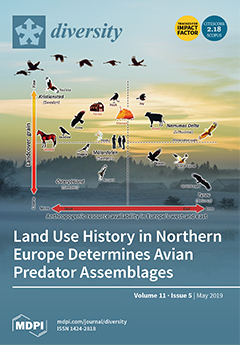Home range (HR) studies are a particularly common approach to investigations of animal habitat use, resource availability, and response to management manipulation such as relocations.
Terrapene carolina (Eastern box turtle) and its sister taxon
T. ornata (Ornate box turtle) are especially popular subjects
[...] Read more.
Home range (HR) studies are a particularly common approach to investigations of animal habitat use, resource availability, and response to management manipulation such as relocations.
Terrapene carolina (Eastern box turtle) and its sister taxon
T. ornata (Ornate box turtle) are especially popular subjects of HR studies because they are relatively easily tracked.
Terrapene HR studies have revealed a wide variation in HR sizes within and between populations, due to factors such as differences in ecoregion and analytical approach (e.g., minimum convex polygons, kernel analysis, bivariate normal, multivariate Ornstein–Uhlenbeck stochastic process, harmonic means). We performed a meta-analysis of the available literature, including unpublished work to avoid bias due to under-publication, to explore the causes for variation in HR size. We found 19 studies reporting
T. carolina HR sizes and seven studies reporting
T. ornata HR sizes; the resulting meta-analysis revealed patterns that are not visible in the individual studies. We found important differences between the species: female
T. ornata had smaller HRs than males, whereas the opposite is true for
T. carolina, and
T. ornata HRs were influenced by ecoregion, while
T. carolina HRs were not similarly influenced. Not surprisingly, we found that choice of analysis technique affected HR estimate; analyses using ellipses resulted in larger HR estimates than all the other techniques, while kernels were smaller than minimum convex polygons. Although not indicated by individual studies, our meta-analysis showed that the HRs of relocated
T. carolina females were significantly larger than those of non-relocated females. Although the number of individual turtles in studies varied from three to 25, the sample size did not significantly affect HR size.
Full article





